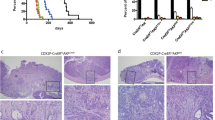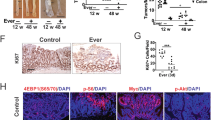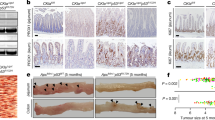Abstract
The adenomatous polyposis coli (APC) gene encodes APC tumour suppressor protein, germline mutation of which causes familial adenomatous polyposis, an autosomal intestinal cancer syndrome. We have previously demonstrated that the proto-oncogene c-Myc is essential for all the phenotypes that occur after APC loss in the murine small intestine. One caveat to this study is that it was performed in the complete absence of c-Myc. In this study, we show that heterozygosity for Myc reduces the phenotypes of APC loss and Wnt target gene expression and slows tumourigenesis. Crucially, the levels of Myc are twofold higher than wild-type levels showing that the level of Myc induced by Wnt signalling is absolutely vital for the fate of APC-deficient cells. Taken together, this suggests that c-Myc inhibition may be a viable chemoprevention strategy for colorectal cancer.
This is a preview of subscription content, access via your institution
Access options
Subscribe to this journal
Receive 50 print issues and online access
$259.00 per year
only $5.18 per issue
Buy this article
- Purchase on Springer Link
- Instant access to full article PDF
Prices may be subject to local taxes which are calculated during checkout



Similar content being viewed by others
References
Andreu P, Colnot S, Godard C, Gad S, Chafey P, Niwa-Kawakita M et al. (2005). Crypt-restricted proliferation and commitment to the Paneth cell lineage following Apc loss in the mouse intestine. Development 132: 1443–1451.
Baena E, Gandarillas A, Vallespinos M, Zanet J, Bachs O, Redondo C et al. (2005). c-Myc regulates cell size and ploidy but is not essential for postnatal proliferation in liver. Proc Natl Acad Sci USA 102: 7286–7291.
Bienz M, Clevers H . (2000). Linking colorectal cancer to Wnt signaling. Cell 103: 311–320.
Bommer GT, Fearon ER . (2007). Role of c-Myc in Apc mutant intestinal phenotype: case closed or time for a new beginning? Cancer Cell 11: 391–394.
Ciznadija D, Tothill R, Waterman ML, Zhao L, Huynh D, Yu RM et al. (2009). Intestinal adenoma formation and MYC activation are regulated by cooperation between MYB and Wnt signaling. Cell Death Differ 16: 1530–1538.
Finch AJ, Soucek L, Junttila MR, Swigart LB, Evan GI . (2009). Acute over-expression of Myc in intestinal epithelium recapitulates some but not all the changes elicited. Mol Cell Biol 29: 5306–5315.
Gregorieff A, Clevers H . (2005). Wnt signaling in the intestinal epithelium: from endoderm to cancer. Genes Dev 19: 877–890.
He TC, Sparks AB, Rago C, Hermeking H, Zawel L, da Costa LT et al. (1998). Identification of c-MYC as a target of the APC pathway. Science 281: 1509–1512.
Ignatenko NA, Holubec H, Besselsen DG, Blohm-Mangone KA, Padilla-Torres JL, Nagle RB et al. (2006). Role of c-Myc in intestinal tumorigenesis of the ApcMin/+ mouse. Cancer Biol Ther 5: 1658–1664.
Jubb AM, Chalasani S, Frantz GD, Smits R, Grabsch HI, Kavi V et al. (2006). Achaete-scute like 2 (ascl2) is a target of Wnt signalling and is upregulated in intestinal neoplasia. Oncogene 25: 3445–3457.
Kinzler KW, Nilbert MC, Su LK, Vogelstein B, Bryan TM, Levy DB et al. (1991). Identification of FAP locus genes from chromosome 5q21. Science 253: 661–665.
Korinek V, Barker N, Morin PJ, van Wichen D, de Weger R, Kinzler KW et al. (1997). Constitutive transcriptional activation by a beta-catenin-Tcf complex in APC-/- colon carcinoma. Science 275: 1784–1787.
Murphy DJ, Junttila MR, Pouyet L, Karnezis A, Shchors K, Bui DA et al. (2008). Distinct thresholds govern Myc's biological output in vivo. Cancer Cell 14: 447–457.
Pomerantz MM, Ahmadiyeh N, Jia L, Herman P, Verzi MP, Doddapaneni H et al. (2009). The 8q24 cancer risk variant rs6983267 shows long-range interaction with MYC in colorectal cancer. Nat Genet 41: 882–884.
Sansom OJ, Meniel V, Wilkins JA, Cole AM, Oien KA, Marsh V et al. (2006). Loss of Apc allows phenotypic manifestation of the transforming properties of an endogenous K-ras oncogene in vivo. Proc Natl Acad Sci USA 103: 14122–14127.
Sansom OJ, Meniel VS, Muncan V, Phesse TJ, Wilkins JA, Reed KR et al. (2007). Myc deletion rescues Apc deficiency in the small intestine. Nature 446: 676–679.
Sansom OJ, Reed KR, Hayes AJ, Ireland H, Brinkmann H, Newton IP et al. (2004). Loss of Apc in vivo immediately perturbs Wnt signaling, differentiation, and migration. Genes Dev 18: 1385–1390.
Shchors K, Shchors E, Rostker F, Lawlor ER, Brown-Swigart L, Evan GI . (2006). The Myc-dependent angiogenic switch in tumors is mediated by interleukin 1beta. Genes Dev 20: 2527–2538.
Shibata H, Toyama K, Shioya H, Ito M, Hirota M, Hasegawa S et al. (1997). Rapid colorectal adenoma formation initiated by conditional targeting of the Apc gene. Science 278: 120–123.
Soucek L, Whitfield J, Martins CP, Finch AJ, Murphy DJ, Sodir NM et al. (2008). Modelling Myc inhibition as a cancer therapy. Nature 455: 679–683.
Tuupanen S, Turunen M, Lehtonen R, Hallikas O, Vanharanta S, Kivioja T et al. (2009). The common colorectal cancer predisposition SNP rs6983267 at chromosome 8q24 confers potential to enhanced Wnt signaling. Nat Genet 41: 885–890.
van der Flier LG, van Gijn ME, Hatzis P, Kujala P, Haegebarth A, Stange DE et al. (2009). Transcription factor achaete scute-like 2 controls intestinal stem cell fate. Cell 136: 903–912.
Wilkins JA, Sansom OJ . (2008). C-Myc is a critical mediator of the phenotypes of Apc loss in the intestine. Cancer Res 68: 4963–4966.
Yekkala K, Baudino TA . (2007). Inhibition of intestinal polyposis with reduced angiogenesis in ApcMin/+ mice due to decreases in c-Myc expression. Mol Cancer Res 5: 1296–1303.
Author information
Authors and Affiliations
Corresponding author
Ethics declarations
Competing interests
The authors declare no conflict of interest.
Additional information
Supplementary Information accompanies the paper on the Oncogene website
Supplementary information
Rights and permissions
About this article
Cite this article
Athineos, D., Sansom, O. Myc heterozygosity attenuates the phenotypes of APC deficiency in the small intestine. Oncogene 29, 2585–2590 (2010). https://doi.org/10.1038/onc.2010.5
Received:
Revised:
Accepted:
Published:
Issue Date:
DOI: https://doi.org/10.1038/onc.2010.5
Keywords
This article is cited by
-
Reversible Myc hypomorphism identifies a key Myc-dependency in early cancer evolution
Nature Communications (2022)
-
OCC-1D regulates Wnt signaling pathway: potential role of long noncoding RNA in colorectal cancer
Molecular Biology Reports (2022)
-
RAC1B modulates intestinal tumourigenesis via modulation of WNT and EGFR signalling pathways
Nature Communications (2021)
-
Brf1 loss and not overexpression disrupts tissues homeostasis in the intestine, liver and pancreas
Cell Death & Differentiation (2019)
-
A NOTCH1-driven MYC enhancer promotes T cell development, transformation and acute lymphoblastic leukemia
Nature Medicine (2014)



